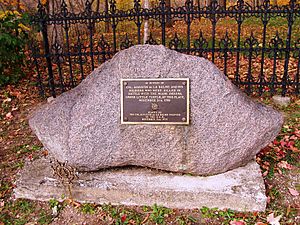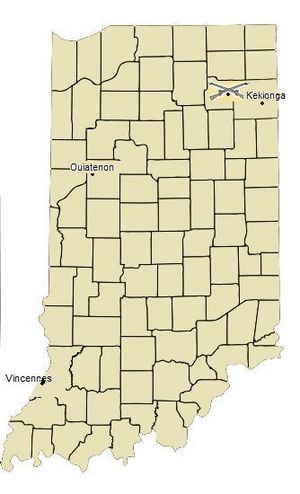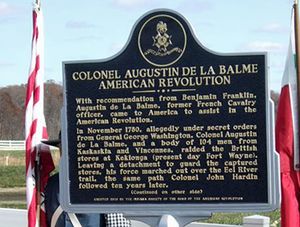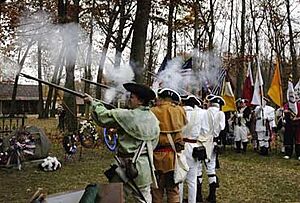La Balme's Defeat facts for kids
Quick facts for kids La Balme's Defeat |
|||||||
|---|---|---|---|---|---|---|---|
| Part of American Revolutionary War | |||||||
 DAR LaBalme Defeat Historical Marker on Dela Balme Road in Whitley County, Indiana |
|||||||
|
|||||||
| Belligerents | |||||||
| Miami tribe | French Colonial Militia | ||||||
| Commanders and leaders | |||||||
| Little Turtle | Augustin de La Balme † | ||||||
| Strength | |||||||
| ? | 104 | ||||||
| Casualties and losses | |||||||
| 5 killed | 30-40 killed | ||||||
La Balme's Defeat was a quick but important battle on November 5, 1780. It happened during the American Revolutionary War. French soldiers from the Illinois Country fought against Miami warriors. The French were led by a cavalry officer named Augustin de La Balme. The Miami forces were led by Little Turtle (Mihšihkinaahkwa).
La Balme wanted to attack Fort Detroit, which was controlled by the British. But first, his group raided the large Miami town of Kekionga. The Miami people then fought back to get revenge. This victory made Little Turtle famous. He became one of the most successful Native American military leaders to fight against the United States Army.
Contents
Why Did La Balme Attack?
Augustin de La Balme came to the United States with other French volunteers. One of them was the Marquis de Lafayette. In 1777, La Balme was made the Inspector General of Cavalry for the Colonial Army. This job meant he checked how the cavalry was doing. Later, Kazimierz Pułaski took over this role. La Balme left the army in October 1777.
However, in 1780, La Balme traveled down the Ohio River to Kaskaskia. He was inspired by General Clark's success. Clark had captured Fort Sackville at Vincennes. La Balme wanted to do the same thing against the British at Fort Detroit.
La Balme's Journey and Plans
When La Balme arrived in Kaskaskia, the local French people welcomed him. They had been living under British rule for over ten years. La Balme said he was a representative of King Louis XVI of France. He collected a list of complaints from the people about the Virginian rulers. He planned to give this list to the French Ambassador at Fort Pitt.
La Balme did not like General Clark. He thought Clark was just an uneducated woodsman. La Balme planned a fake attack on Fort St. Joseph to distract the British. Then, he started his journey to Detroit. He recruited soldiers from the French citizens in Kaskaskia, Cahokia, and Vincennes.
At Vincennes, he went up the Wabash River. He hoped to get more soldiers from the French villages of Ouiatenon (now West Lafayette, Indiana) and Kekionga (now Fort Wayne). La Balme seemed to expect that French people at Fort Detroit would join him when he arrived. He kept the French ambassador, Anne-César de La Luzerne, updated on his plans. His expedition marched under a French flag.
Raid on Kekionga
La Balme's mounted group moved very fast. They didn't face much opposition until they reached Kekionga. La Balme had planned to arrest Charles Beaubien, who was a British agent there. But Beaubien and many of the Miami were not in the town.
So, La Balme's group raised the French flag. They raided British supply stores for two weeks. They were waiting for more soldiers to join them, but none arrived. La Balme then learned that a Miami hunting party was returning to Kekionga. He decided to leave and raid another trading post on the Eel River. La Balme left twenty French soldiers to guard the captured supplies at Kekionga. He marched his main force out along the Eel River trail.
The Battle of La Balme's Defeat
The Miami people learned about the invasion. They quickly destroyed the small group of 20 French soldiers left at Kekionga. All of them were killed. Little Turtle lived in a village along the Eel River. He got permission from the Kekionga Miami to lead an attack. He gathered his available warriors.
Little Turtle attacked La Balme's camp at dawn on November 5. This was before La Balme reached the Eel River trading post. The camp was only about 3 miles from Little Turtle's village.
The Attack and La Balme's Death
The first person killed in the attack was a French soldier named Antoine Rembault. He was serving as a lookout for La Balme's forces. As Rembault warned the other French soldiers, Little Turtle hit him in the head with a tomahawk. The tomahawk went deep into Rembault's head.
La Balme and his men tried to defend themselves on the river banks. But they could only fire one shot before the Miami warriors overwhelmed them. The battle was very one-sided. Only a few French soldiers managed to escape. Many French soldiers were heard begging to surrender. La Balme also died in this battle. This is why it became known as "La Balme's Defeat."
A group of French officers were captured alive by Little Turtle on purpose. Three of these captured officers were later killed. The remaining four were set free. This was a warning to the rest of the French forces.
A few days later, French forces allied with the Americans tried to scout the area. They saw that the path was blocked and turned back. These events happened near what is now Columbia City, Indiana in Whitley County, Indiana. Later, on December 5, 1780, a small group of French soldiers, following old orders from La Balme, were also defeated by Miami forces at Petit Fort, Indiana.
What Happened After the Battle?
- Little Turtle became famous for his leadership in this battle. This started his successful career as a military commander in the Northwest Indian War. About 11 years later, he led an attack that was one of the worst defeats in U.S. Army history.
- Even though La Balme's trip failed, it worried the British a lot. Major de Peyster sent British Rangers to protect Kekionga.
- The Miami tribes had been neutral or even favored the United States. But they were very angry about the attack on Kekionga. They then joined forces with the British.
- Fort Detroit stayed under British control until the Jay Treaty was approved in 1796. (Detroit was given back to the British during the War of 1812, but returned to the U.S. after that war ended.)
Remembering La Balme's Defeat
- In northeast Indiana, near the Allen and Whitley County line, along the Eel River, there is a brass and stone marker. The Daughters of the American Revolution placed it in 1930. It says: "In memory of Col. Augustin de La Balme and his soldiers who were killed in battle with the Miami Indians under Little Turtle at this place, November 5, 1780."
- On November 5, 2005, the Indiana Society Sons of the American Revolution put up a bronze marker. They also celebrated the 225th anniversary of the event. Descendants of Revolutionary War soldiers and Miami Indians took part in the ceremony.
- On November 6, 2010, the Indiana Society Sons of the American Revolution put up another bronze historical marker to remember the event.




